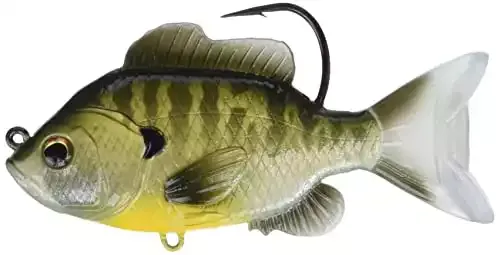Bluegill has been the secret to success for many anglers over the years, probably considered one of the best live bait options for both catfish and bass. However, producing quality results by using bluegill as live bait isn’t as simple as just hooking the fish and casting it out.
There are some small key elements to consider in order to maximize your live bluegill bait and produce a worthy catch.
The main idea is that the bluegill stays alive while on a hook. You will want to hook the bluegill in a way that keeps the fish swimming for a longer period of time.
Let’s have a look at some of the key tips for learning how to use bluegill as live or dead bait.
Is Bluegill Good Bait?
Yes, bluegill is good bait for fishing. Bluegill, also known as bream, are a popular bait fish because they are readily available in many freshwater bodies such as lakes, ponds, and rivers. They are also a common prey for many predatory fish species, so using bluegill as bait can attract a variety of fish.
When using bluegill as bait, you can either use them whole or cut them into smaller pieces, depending on the fish you target.
Remember that bluegill is primarily a freshwater fish species, and its effectiveness as bait for saltwater fishing is limited.
It’s important to check the fishing regulations in your area to ensure that using bluegill (or any sunfish) as bait is allowed and to understand any size or quantity restrictions.
How Long Can Bluegill Live Out of Water?
Bluegill is a freshwater fish that can only survive for a short time out of the water, typically ranging from a few minutes to a couple of hours.
In optimal conditions, where the fish is kept moist and cool, they may be able to survive a bit longer.
Can You Use Dead Bluegill as Bait?
Yes, you can use dead bluegill as bait.
If you have freshly caught bluegill, they can be a great option. However, if you use previously frozen dead bait, ensure they are thawed properly before use.
Depending on the fishing technique and target species, you can rig dead bluegill in various ways. For example, you can thread chunks of bluegill onto a hook, use them as cut bait, or even use them in conjunction with a fishing rig like a Carolina rig or slip rig.
What Fish Are Attracted to Bluegill Bait?
Bluegill bait can attract a variety of fish species, especially predatory fish. Some common fish species that are attracted to Bluegill bait include:
Largemouth Bass: Largemouth bass are known to prey on bluegill. Using live or cut bluegill as bait can be effective in enticing these popular game fish.
Smallmouth Bass: Similar to largemouth bass, smallmouth bass also feed on bluegill.
Catfish: Both channel catfish and flathead catfish are attracted to bluegill.
Pike: Northern pike are aggressive predators and will often strike at bluegill bait.
Muskie: Muskie, also known as muskellunge, are large predatory fish that can be targeted using bluegill as bait.
Where to Catch Bluegill?
They are commonly found in lakes, ponds, rivers, and reservoirs.
When fishing for bluegill, use small hooks, light tackle, and bait such as worms, crickets, small jigs, or even bits of bread or corn.
How to Hook a Bluegill as Live Bait
The two most important elements when fishing with live bluegill as bait is that the fish can remain alive for a long period of time and that it closely resembles the natural swimming motion of a bluegill.
For the best results, try to use bluegill that are small enough in order to appeal to most fish. The recommended length for using bluegill as bait is anything smaller than 6 inches (preferably 3-4 inches long).
The best option for keeping your bluegill bait alive for a long period of time is to hook the fish through the lips. I recommend hooking through the bottom lip first and coming out through the top lip. The hook will seal the lips of the bluegill shut.
The downside to this method is that the bluegill tends to fish toward the surface of the water. However, this can be acceptable if you are fishing for catfish or bass near the top of the water.
Another option for having your bluegill bait resemble its natural swimming motion is to hook the fish through the body directly in front of the tail. I recommended hooking the bluegill in the back side of its body as it allows the fish to swim downwards, making it look more appealing to a predatory fish. The live bluegill tends to cover more area within the water when they are hooked this way.
Check this video on how to use a live bluegill as bait.
How to Use Live Bluegill as Bait for Big Bass
When fishing for bass, It is recommended to hook the bluegill right behind the dorsal fin. An effective method for luring bass to your bait is to pull the line when the bluegill is hooked. This pulling motion forces the bluegill to swim sideways, which makes the fish appear injured to a hungry bass in the area.
We have seen live bluegill work extremely well for big bass. Do not worry if you think your 3-5 inch bluegill may be too big, as you would honestly be shocked at the size of bass that would still take the bait.
Some say that this method works better in ponds compared to lakes. However, we have seen live bluegills work well as bait for catching large bass in both locations.
Bluegill as Catfish Bait
Using bluegill as bait for catfish is highly effective.
When using bluegill as catfish bait, ensure the pieces are large enough to entice the catfish but still manageable for rigging.
Fresh bluegill bait is generally more enticing to catfish. If possible, use live bluegill or fresh-caught ones.
Use a suitable rigging method, such as a Carolina rig, slip rig, or simply thread the bluegill chunks onto a large circle hook.
How to Use Bluegill Cut Bait for Catfish
If you do not have the luxury of having live bluegill as bait – the other recommended alternative is cut bait. As simple as it sounds, this bait is just a piece of the whole fish cut up.
Cut bait works extremely well for catfish. Some of the biggest blue catfish and large channel catfish are usually caught with cut bait.
As you cut the fish, the gills and head of the bluegill are some of the most attractive pieces because catfish focus in on the blood of the bluegill. Catfish can easily smell the scent of blood.
Cut bait is great because it can be easily purchased in a typical tackle & bait shop or even caught on your own. If you happen to catch live bluegill and know that you won’t be fishing anytime soon to utilize them as live bait, freeze the fish to use later for cut bait.
When you are ready to go fishing, simply defrost the frozen bluegill and cut the fish into strip-like pieces.
Do Artificial Bluegill Lures Work?
Artificial bluegill lures have been quite successful from our fishing experiences. Any lure that resembles the look of either a bluegill or crappie will work.
Also, you will want the lure to closely resemble the typical swimming motion of a bluegill. It always helps to have a lure that features the realistic patterns of the fish.
You can find a link below, which we feel is the best artificial bluegill lure, available on Amazon.
Features an anatomically correct profile and an oscillating tail, which generates a natural side-to-side tail kicking action. It comes with a stout extra wide gap hook for increased hooking power.
Is it Illegal to use bluegill as bait?
Many states outlaw the use of sport fish as a method for bait. Unfortunately, bluegill falls into this category for several states.
Please check the local fishing regulations in your area to confirm if this bait is allowed.
Using live bluegill as bait can be illegal because of the risk of bringing an unwanted species into a new environment. Invasive species can have a negative impact on the long-term health of the environment as they initially join the ecosystem without any true predators.
Without any true predators, the fish can live freely utilizing the resources needed for other species, which can cause great economic harm. Understand the laws in your area to avoid having any conflict with the authorities.
To Sum Up
According to the U.S. Fish and Wildlife Service, a bluegill is one of the most popular sport fish in the United States. Using bluegill as your bait can be an extremely effective method for catching large bass and catfish.
As long as it is allowed by the laws in your state, it is a great way to improve your fishing experience.
Using artificial bluegill lures can be an ideal way to counter strict state laws.




